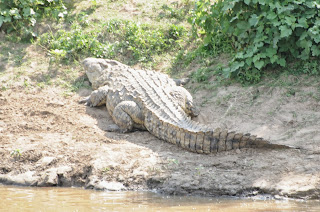Among many reptile species in Africa, the crocodiles have
somehow stolen the arena by being the most vocal and other adaptations. Unlike
other reptiles they do not shed their skin and instead grow with it.
These dinosaur-like creatures are usually spotted while basking in the early
morning sun and late afternoon on the river banks. In the middle of the day
when temperatures are higher they lie in the shallow waters sometimes with half
of the body partially submerged. It is their way of warming up or cooling
behavior.
Being creatures of the water, they are great swimmers and
divers. Their respiratory
System has a tissue flap that seals off while under water.
These enable them to open the mouth and not choke underwater. In addition, crocodile's
nostrils close while diving and the same case happens with the external ears.
Most reptiles do not have the external ears. Their vision under the water is
very good and is facilitated by the nictitating membrane (transparent third eye
membrane). This keeps water out of the eye hence no vision interference.
What's more, the tail acts as a oars that helps them
maneuver while in the water. They use the tail also for feeding whereby they
can disorient schools of fish with strong strokes and catch them. Crocodiles
never stay far away from the water. Incase the pool or swamp dries they too
die. Their preference is the permanent rivers but on occasions they can be
spotted in seasonal rivers especially during the heavy rains whereby they avoid
the strong currents. Immediately when the rain subsides they return to their
territories.
On land, the crocs can walk fairly fast, up to about 28 miles an hour. Although
the back legs are webbed, this does note interfere with their walking on land.
Despite this, they do not wader too far from the water. Though they are termed
as hunters, their hunting method mostly lying low and wait for their victims to
come to drink. Then they thrash forward and grab them, drag and drown them
under the water. Their teeth are especially formatted to seize and hold the
prey. With crocodiles you can see the two front teeth of the lower jaw.
These lizard-like reptiles live in big groups and can be
up to several hundreds. Usually the big males are in charge but it is more of
domination than organized social leadership. There is no known coordinated
group activity apart from feeding together.
There feeding method is by tearing chunks from the victim
and this may sometimes include spinning of the whole body while holding tight
with the teeth.
The crocodile (Nile crocodile) reach sexual maturity at
the age of 8-12 years. Then they can mate, and after about 60 days the female
is ready for laying eggs. She digs a hole and lays her eggs there. She can lay
between 20-90 eggs. The eggs are heavily calcified and chicken-egg sized.
Inside the buried egg, the temperatures rise to over 90 degrees. After about 90
days later the hatchlings calls for the mother through hissing and she digs
them out. Then she moves them to the water. This is a critical stage as most of
them are predated on. Among the predators includes birds of prey,( eagles,
hawks, vultures..), monitor lizards, among others. Usually when the mother
senses danger to her young ones she can put them inside the mouth (gular pouch)
for protection. The few survivors are free from the mother after two years and
ready to face the world alone.
Note that crocodiles have no sweat glands. They lose heat
through their mouths cavities. You will see them sun-bathing with the mouth
open and sometimes panting like dogs. Their color ranges from dark green, to a
black-grayish but with a lighter belly. The body is covered with scales and
they never shed them.
Their diet varies from small to large animals and in
Kenya they have been known to catch birds. Their ectothermic metabolism is very
efficient in that the huge crocs can stay for several months without food.
Crocodile have been known to attack and kill people.
There are many cases of cows being attacked when they come to drink. Though
CITES have classified them endangered, the populations in Kenya and Tanzania
are very healthy.It is their habitat that is in constant danger from intrusion,
pollution and fishermen's nets.
Peter K.
Philip
Adventure Kenya camping safaris,
Natural
Track Safaris


No comments:
Post a Comment